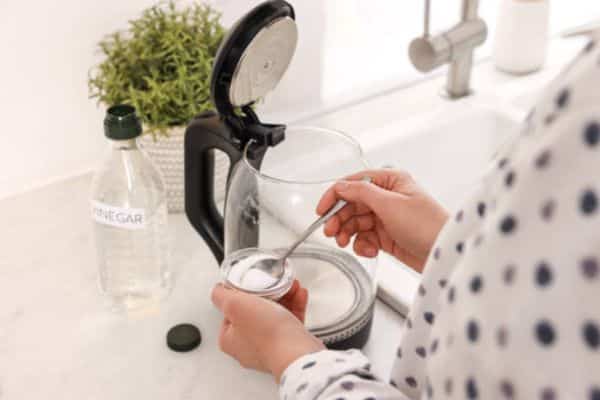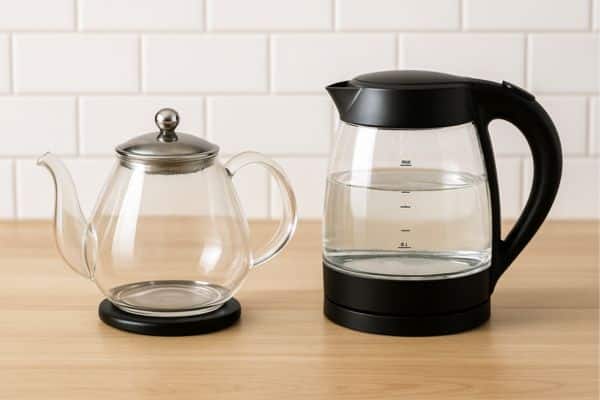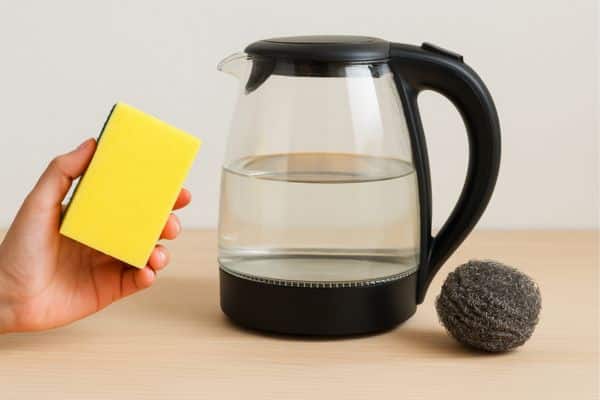I love watching water boil in a glass tea kettle. It feels calm. Simple. Like a quiet moment before the day begins. But over time, I noticed a problem. The glass turned dull. The water didn’t taste as fresh. My morning tea lost its charm. That’s when I learned how to clean a glass tea kettle the right way. A quick rinse wasn’t enough. It needed care. And once I gave it that, the kettle looked new again. The tea? Brighter. Cleaner. Better. This guide shows you how. You’ll learn what to use, the steps that work, and easy tips to keep your kettle clean. I’ll also share a few tricks with vinegar and how to care for electric kettles too.
Quick Signs Your Glass Tea Kettle Needs Cleaning
A clean glass kettle looks like crystal. You can see right through it. The water swirls and shines. But once the glass turns cloudy, it’s a sign the magic is fading.
A white film or limescale on the inside means minerals are building up. This often happens in areas with hard water. It sneaks up slowly, but you’ll spot it on the bottom or around the spout.
Tea may start tasting off, even with fresh leaves or bags. That odd flavor or dull taste? It’s often caused by leftover residue inside the kettle. I noticed it most with green teas. The flavor fell flat, even though I brewed it just right.
Boiling water may take longer than usual. That’s because the scale acts like a barrier. It slows the heat from reaching the water. You end up waiting more and sipping less.
What You’ll Need Before You Start

Before you dive into the cleaning steps, grab a few simple things from the kitchen. No fancy tools. Just gentle, safe items that get the job done.
White vinegar is your best friend. It breaks down limescale and leaves no harsh smell. It’s natural, cheap, and works like magic.
Baking soda helps with tough stains. It’s not a must, but I keep it close just in case. It adds a soft scrub without scratching the glass.
A slice of lemon brings freshness. It smells great and boosts the vinegar’s power. Plus, it leaves your kettle smelling bright and clean. Plain water, of course. You’ll use it to mix, boil, and rinse. Easy.
A soft sponge or cloth protects the glass. No rough pads or metal brushes—just something kind and gentle.
Step-by-Step Guide

01. Empty the kettle
Pour out any leftover water. Shake it gently to remove loose bits inside. Starting fresh makes the rest easier.
03. Add vinegar and water
Fill the kettle halfway with white vinegar. Then add the same amount of water. A 1:1 mix works best to break down buildup fast.
03. Boil the solution

Turn the kettle on and let it boil. This softens the scale and lifts the cloudiness. The mix may smell strong, but that’s normal. It means it’s working.
04. Let it sit
Turn off the kettle and leave the solution inside for 15 to 20 minutes. This gives the vinegar time to do its job. Stubborn spots will loosen up during this soak.
05. Scrub gently with a sponge
After the soak, use a soft sponge or cloth. Wipe the inside and around the spout. Don’t press too hard—just light, circular motion does the trick.
06. Rinse well
Rinse the kettle a few times with clean water. This clears out any vinegar left behind. For a fresh finish, you can boil plain water once and toss it.
Bonus Tip: How to Clean Kettle With Vinegar for Deeper Descaling
Some stains don’t go away on the first try. That’s where vinegar steps in—and shines.
Vinegar works because it breaks down limescale without damaging the glass. It reaches into the tiny spots you can’t scrub. It’s gentle, But strong enough to lift thick mineral layers.
For tougher buildup, pour in a mix of equal parts vinegar And water. Let it sit For about an hour before boiling. The longer soak helps soften the hard scale stuck to the bottom and sides. After boiling, leave it to cool For another 20 minutes, then rinse and wipe.
Repeat this routine every few weeks if your water is hard Or you use the kettle daily. You’ll keep stains from forming, And your tea will always taste clean and pure.
How To Clean an Electric Kettle vs. Glass Kettle

Glass look clear and elegant. Electric kettles focus more on speed and function. But both need cleaning to work well—And to make tea taste its best.
The big difference is safety. A glass kettle often goes on the stove. An electric kettle has a built-in base or heating element. That means you can’t soak Or rinse the whole unit like you would with glass.
To clean an electric pot, use the same vinegar and water mix. Fill it halfway, boil, then let it sit. Don’t let water touch the base or plug. Once it cools, pour it out and wipe inside with a soft sponge. Looking for a safer option? Check out the best non toxic electric tea kettle for a cleaner, healthier brew.
How Often Should You Clean Your Glass Kettle?
Clean your kettle at least once a week if you use it every day. A quick rinse won’t do the job. Limescale builds fast, especially in hard water areas.
For lighter use, a full clean every two to three weeks is fine. Watch for signs like cloudy spots, slow boiling, or off-flavours in your tea. These are ways of saying, “Help me out!”
Keeping a routine helps you last longer. And it keeps every cup tasting fresh and clean—just the way it should.
Safe Practices and Common Mistakes to Avoid

Always use a soft sponge or cloth. Steel wool or harsh brushes can scratch the glass. Scratches hold on to buildup and ruin that smooth, clear look.
Never submerge an electric base. Even a little water near the plug or buttons can cause damage. Always unplug before cleaning, and keep the base dry.
Rinse well after using vinegar. The taste can linger if you don’t flush it out fully. A final boil with clean water helps remove any last bit of smell or residue.
Final Thoughts
There’s something peaceful about the whole process—boiling water, steeping leaves, taking that first warm sip. A clean glass kettle makes it even better. It’s not just about clear water or pretty glass. It’s about care. About taking a moment for yourself.
Cleaning doesn’t have to be a chore. It can be part of the ritual. A simple way to respect the tea, the time, and the tools that make it all possible
FAQ
Can I use lemon instead of vinegar?
Yes, lemon works well for light cleaning. It helps remove mild stains and adds a fresh scent. Vinegar is better for deep descaling.
What’s the safest way to clean an electric glass kettle?
Use a vinegar and water mix. Boil, let sit, and rinse well. Always unplug and never get the base wet.
Is baking soda safe for glass kettles?
Yes, baking soda is safe and gentle. It helps remove tough spots without scratching the surface

